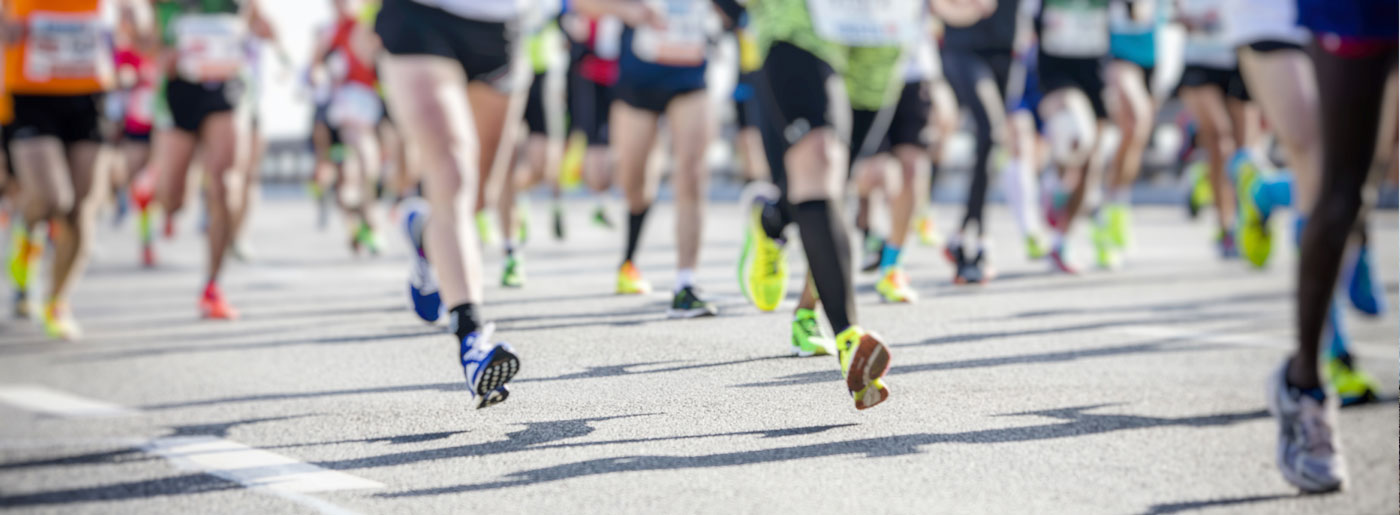The marathon is the ultimate challenge for many runners. But, before you can run the marathon, you have to handle running a 5K and 10K. That’s nothing compared to a marathon? Maybe not, but these shorter distances are hard work, too, and not just for newbies.
Here’s what RRCA-certified running coach Megan Harrington says you should know before running a 5K, 10K, half marathon, and marathon. She is an 18:52 5K runner, 42:28 10K runner, 1:31 half marathoner, and holds a 3:18 marathon PR.
What runners need to know before running a 5K
If you’re new to running, signing up for a 5K is a great way to stay motivated and work toward a specific goal. And if you’re a seasoned runner, training for a 5K can help you get faster and experience that familiar runner’s high in less time than it takes to watch an old episode of Seinfeld.
The 5K may be small in comparison to a marathon, but those 3.1 miles can pack a mighty punch. Keep these three key points in mind before running a 5K.
-
Don’t go from zero to 5K overnight
“If you can walk or run 2–3 miles, you’re probably ready for a 5K race,” Harrington says. “If this will be your first 5K, give yourself at least a month to increase mileage and aim to run at least four miles before race day.”
-
5Ks are beginner-friendly – but they’re not just for running newbies
“Sometimes people think 5Ks are only for beginners, but that’s not so,” Harrington says. “Training for and racing a fast 5K is hard work, and can be very rewarding. If you’re shooting for a fast time, include short intervals in your training. A class speed workout is 12 x 400m repeats at 5K race pace with a 200m recovery jog.”
-
It might hurt – and that’s not a bad thing!
“Most of the 5K race will feel difficult,” Harrington says. “It is a short race, after all. But if you can, shoot for negative splits. That means your miles get progressively faster. I like to keep mile one in the yellow (medium) zone, mile two in the orange (pretty hard) zone, and mile three in the red zone, which is going all out.”
3 things to know about 10K TRAiNING
To many, the 10K is the perfect race distance. At 6.2 miles, it’s long enough to feel tough and satisfying, but short enough that you can still run hard and fast. Plus, unlike a marathon, the training doesn’t totally take over your life.
But to others, the 10K is the ultimate challenge: It gives you just enough time to totally burn out, and going out too fast can seriously hinder your overall performance. To avoid this, consider these three things before you start training.
-
Run longer than the race distance
“Even though a 10K race is only 6.2 miles, try to work up to some longer runs during training, somewhere in the 8–10-mile race,” Harrington says. “Running ‘over distance’ will improve your endurance and help you stay strong during those later miles in the race.”
-
Study up before race day
“Before you start training, scout out the race course you’re planning on running,” Harrington says. “Is it hilly? Does it have a lot of turns? Will it be very crowded? Once you’re familiar with the terrain, you can create a training and race strategy. For example, if you’ll be making a lot of turns, practice running the course tangents, which is the shortest legal distance of the course.”
-
Mix it up
“Try adding long intervals to your training,” Harrington says. “A favorite workout of mine is 4–5 x 1-mile repeats at 10K race pace with a ¼-mile recovery jog.”
5 things to keep in mind before running a half marathon
There’s a reason the half marathon is the fastest-growing race distance in the U.S. Sure, it’s a popular bucket-list item for many, but running 13.1 miles is hard. Committing to a half marathon will probably somewhat drastically affect your lifestyle – and your hunger levels – but the feeling you’ll get when you cross that finish line is one you’re likely to remember forever.
Whether you just committed to your first or your fiftieth, here are five things to keep in mind.
-
On aches and pains
“If you’re new to distance running, the mileage and workouts that come with half-marathon training can be a bit of a shock to the system,” Harrington says. “If you’re especially sore or achy, take a rest day. It’s better to nip potential injuries in the bud as soon as you can.”
-
On mileage
“The minimum number of running days I’d recommend for half-marathon training is three,” Harrington says. “A long run, a speed workout, and an easy day. If you can run four or five days per week, that’s even better.”
-
On braving – and dressing for – the elements
“Race day might bring rain or wind or heat, so try to do at least one long run in race outfits that work for a variety of conditions,” Harrington says. “Braids and spandex are my go-tos for rainy runs!”
-
On going long
“For most runners, I suggest completing a long run of 13–15 miles before race day,” Harrington says. “If you’re a beginner or are prone to injuries, consider maxing out at 11 or 12 miles.”
-
On workouts
“Long tempo runs are great workouts to help prepare you for a half marathon,” Harrington says. “Try warming up for a mile or two and then running 4–5 miles at half-marathon goal pace. Then cool down for a mile or so afterward.”
5 marathon training rules to swear by
The marathon. 26.2 miles. For a runner, it’s the ultimate challenge. It means committing your life to training – at least for a few months – spending your Saturday mornings running for hours at a time, and, on race day, willingly running further than most people drive in a week.
But there’s that allure. That challenge. That “can I do this?” Then the “I will do this.” And finally, “I just did that.”
Megan Harrington loves the distance but says mastering it requires some serious mental and physical strength. Here are her five best pieces of advice for new and veteran marathoners alike.
-
Get ready to do a lot of easy running
“It’s important to do the bulk of your training miles at an easy training pace,” Harrington says. “If you run too fast, too often your body won’t be able to recover between workouts. For example, if you’re shooting for a four-hour marathon, which means running around a 9-minute per mile pace, most of your training mileage should be in the 10-minute-mile range.”
-
It’s about more than just running
“As mileage and intensity increase, make sure you’re paying extra attention to sleep and nutrition,” Harrington says. “You want to arrive at the finish line healthy.”
-
Consider the 20-mile training run
“Your mileage and workouts will depend on your goals and your running history, but I recommend runners do at least one 20-mile run before race day,” Harrington says. “If you’re training for a specific time, try to run some — but not all — of your long run miles at your goal race pace.”
-
Train your taste buds, too
“You will need to fuel and hydrate on race day, so practice your fueling strategy during your long runs,” Harrington says. “Make sure to drink and eat before you start feeling woozy or overly fatigued.”
-
No really, slow down
“If there’s one piece of advice I could give every single marathoner, it’s do not go out too fast,” Harrington says. “Things should feel easy – almost too easy – in the first half of the race. If it doesn’t feel easy, slow down. It’s a great feeling to still have energy and to pass runners in those final miles.”
And remember: Listen to your body and your own ambition – not everybody has to go for the marathon. As said, running 5Ks and 10Ks can be just as challenging and rewarding if you just keep it interesting and spice up your training with, for example, tempo runs and interval training.
In the spotlight

megan Harrington
If you liked this post, don’t forget to share so that others can find it, too.
Or give it a thumbs up!
I like this article
Please note that the information provided in the Polar Blog articles cannot replace individual advice from health professionals. Please consult your physician before starting a new fitness program.





